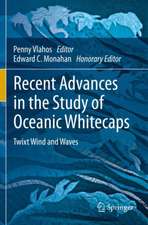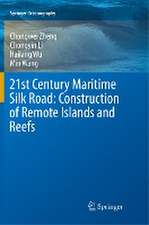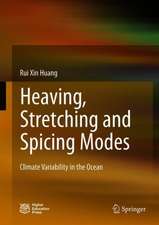Marine Algal Bloom: Characteristics, Causes and Climate Change Impacts
Autor Santosh Kumar Sarkaren Limba Engleză Hardback – 14 mai 2018
The book discusses the occurrence of harmful algal blooms (HABs) caused by the dinoflagellates of the genus Alexandrium and Karenia, or diatoms of the genus Pseudo-nitzschia, which have large and varied impacts on marine ecosystems (such as large-scale marine mortality events that have been associated with various types of shellfish poisonings) depending on the species involved, the environment where they are found, and the mechanism by which they exert negative effects. HABs represent a major environmental problem in all regions of the U.S., and their occurrence is on the rise due to increased nutrient pollution.
HABs have severe impacts on human health, aquatic ecosystems, and the economy. Such blooms, known colloquially as red tides due to their red or brown hues, are increasing in frequency and magnitude worldwide as a result of changes in oceanic climate, increased coastal eutrophication and enhanced long-distance dispersal in ballast water. As such, the book offers an in-depth account of the complex biological, chemical and physical interactions of the algal blooms (both innocuous and harmful ones). It also discusses the highly topical issue of the impact of global climate change on the frequency and severity of HABs in the context of alterations in temperature, stratification, light and ocean acidification.
Focusing on both basic and applied limnology, this book is a reliable and up-to-date referenceresource for students, teachers and researchers engaged in the field of coastal research/management at regional and global scales.
| Toate formatele și edițiile | Preț | Express |
|---|---|---|
| Paperback (1) | 578.70 lei 43-57 zile | |
| Springer Nature Singapore – 19 ian 2019 | 578.70 lei 43-57 zile | |
| Hardback (1) | 727.48 lei 43-57 zile | |
| Springer Nature Singapore – 14 mai 2018 | 727.48 lei 43-57 zile |
Preț: 727.48 lei
Preț vechi: 887.18 lei
-18% Nou
Puncte Express: 1091
Preț estimativ în valută:
139.21€ • 145.71$ • 115.86£
139.21€ • 145.71$ • 115.86£
Carte tipărită la comandă
Livrare economică 31 martie-14 aprilie
Preluare comenzi: 021 569.72.76
Specificații
ISBN-13: 9789811082603
ISBN-10: 981108260X
Pagini: 160
Ilustrații: XVI, 172 p. 45 illus., 40 illus. in color.
Dimensiuni: 155 x 235 x 17 mm
Greutate: 0.44 kg
Ediția:1st ed. 2018
Editura: Springer Nature Singapore
Colecția Springer
Locul publicării:Singapore, Singapore
ISBN-10: 981108260X
Pagini: 160
Ilustrații: XVI, 172 p. 45 illus., 40 illus. in color.
Dimensiuni: 155 x 235 x 17 mm
Greutate: 0.44 kg
Ediția:1st ed. 2018
Editura: Springer Nature Singapore
Colecția Springer
Locul publicării:Singapore, Singapore
Cuprins
- Algal Blooms : Basic concepts. - Algal Blooms : Potential Drivers, Occurrences and Impact. - Harmful Algal Blooms (HABs).
Recenzii
“Sarkar (Univ. of Calcutta, India) has written a nicely illustrated, concise, and informative book on harmful algal blooms (HABs), which examines their characteristics, causes, and potential impacts from climate change. … this is a well-done effort that will be useful for those with some background in HABs. Summing Up: Recommended. Advanced undergraduates through faculty and professionals.” (S. T. Meiers, Choice, Vol. 56 (5), 2019)
Notă biografică
Dr. Santosh Kumar Sarkar, Professor of Marine Science, University of Calcutta, has over 30 years of research experience in marine and estuarine ecology, biology and geochemistry. He has been the Principal Investigator for 12 national projects and 8 international research projects in collaboration with eminent scientists. He has engaged in collaborative research work with leading research institutes around the globe, namely, the Institute Rudjer Boskovic, Croatia; Universities of Genoa Milan, Sienna and Venice, Italy; IPIMAR/INRB IP, and the University of Trás-os-Montes e Alto Douro, Portugal; University of Edinburgh, British Geological Survey, UK; University of Wuppertal, Germany; CIIEMAD National Politechnic Institute, Mexico; Centre National de la Recherche Scientifique( CNRS), Marine Microbial Ecology, France; Southern Cross University, Australia; and Vrije Universiteit Brussel, Belgium. He has authored more than 90 peer-reviewed research papers in internationally respected journals, edited a book and contributed several book chapters covering diverse aspects of marine environment. He is the sole author of a number of books: (i) “Loricate Ciliate Tintinnids in a Tropical Mangrove Wetland: Diversity, Distribution and Impact of Climate Change”, Springer in 2014 (ii) “Marine Organic Micropollutants: A Case Study of the Indian Sundarban Mangrove Wetland” Springer (2016) (iii) Trace Metals in a Tropical Mangrove Wetland : Chemical Speciation, Ecotoxicological Relevance and Remedial Measures Springer (2017).
Textul de pe ultima copertă
In the marine environment, single-celled, microscopic, plant-like organisms naturally occur in the well-lit surface layer of any body of water. These organisms, referred to as phytoplankton or microalgae, form the base of the food web upon which nearly all other marine organisms depend. Algal bloom is a rapid increase in or accumulation of the population of about 300 species of algae due to excess nutrients (eutrophication), and is of major global interest as it causes reduction in species diversity, abrupt changes in water quality, and discoloration of the water (green, yellow, brown or red) depending on the species of algae and the type of pigments they contain. Dying blooms can also be an environmental concern as when the cells sink and decay, bacteria break down the organic material, which in turn strips oxygen from the water. This microbial oxygen demand at times leads to very low oxygen levels in the bottom waters, harming aquatic life. Documentation of this sporadic high abundance of algae, together with the significant species richness of the diatoms, requires comprehensive studies in the Sundarban coastal environment, which is facing severe degradation due to natural & anthropogenic stressors. In addition, a better understanding of the effects of algal blooms on seafood quality, the complex biological, chemical and physical interactions and subsequent effects on trophodynamics is needed to develop strategies for effective coastal zone management.
The book discusses the occurrence of harmful algal blooms (HABs) caused by the dinoflagellates of the genus Alexandrium and Karenia, or diatoms of the genus Pseudo-nitzschia, which have large and varied impacts on marine ecosystems (such as large-scale marine mortality events that have been associated with various types of shellfish poisonings) depending on the species involved, the environment where they are found, and the mechanism by which they exert negative effects. HABs represent a major environmental problem in all regions of the U.S., and their occurrence is on the rise due to increased nutrient pollution.
HABs have severe impacts on human health, aquatic ecosystems, and the economy. Such blooms, known colloquially as red tides due to their red or brown hues, are increasing in frequency and magnitude worldwide as a result of changes in oceanic climate, increased coastal eutrophication and enhanced long-distance dispersal in ballast water. As such, the book offers an in-depth account of the complex biological, chemical and physical interactions of the algal blooms (both innocuous and harmful ones). It also discusses the highly topical issue of the impact of global climate change on the frequency and severity of HABs in the context of alterations in temperature, stratification, light and ocean acidification.
Focusing on both basic and applied limnology, this book is a reliable and up-to-date referenceresource for students, teachers and researchers engaged in the field of coastal research/management at regional and global scales.
The book discusses the occurrence of harmful algal blooms (HABs) caused by the dinoflagellates of the genus Alexandrium and Karenia, or diatoms of the genus Pseudo-nitzschia, which have large and varied impacts on marine ecosystems (such as large-scale marine mortality events that have been associated with various types of shellfish poisonings) depending on the species involved, the environment where they are found, and the mechanism by which they exert negative effects. HABs represent a major environmental problem in all regions of the U.S., and their occurrence is on the rise due to increased nutrient pollution.
HABs have severe impacts on human health, aquatic ecosystems, and the economy. Such blooms, known colloquially as red tides due to their red or brown hues, are increasing in frequency and magnitude worldwide as a result of changes in oceanic climate, increased coastal eutrophication and enhanced long-distance dispersal in ballast water. As such, the book offers an in-depth account of the complex biological, chemical and physical interactions of the algal blooms (both innocuous and harmful ones). It also discusses the highly topical issue of the impact of global climate change on the frequency and severity of HABs in the context of alterations in temperature, stratification, light and ocean acidification.
Focusing on both basic and applied limnology, this book is a reliable and up-to-date referenceresource for students, teachers and researchers engaged in the field of coastal research/management at regional and global scales.
Caracteristici
Up-to-date information of the occurrence of algal blooms in global scale Color photographs and illustrations to identify of potential bloom-causative agents Exclusive chapter on harmful algal blooms (HABs) – a global crisis for environmental management Impact of climate change on the occurrence of algal bloom, beneficial to wide audience


















